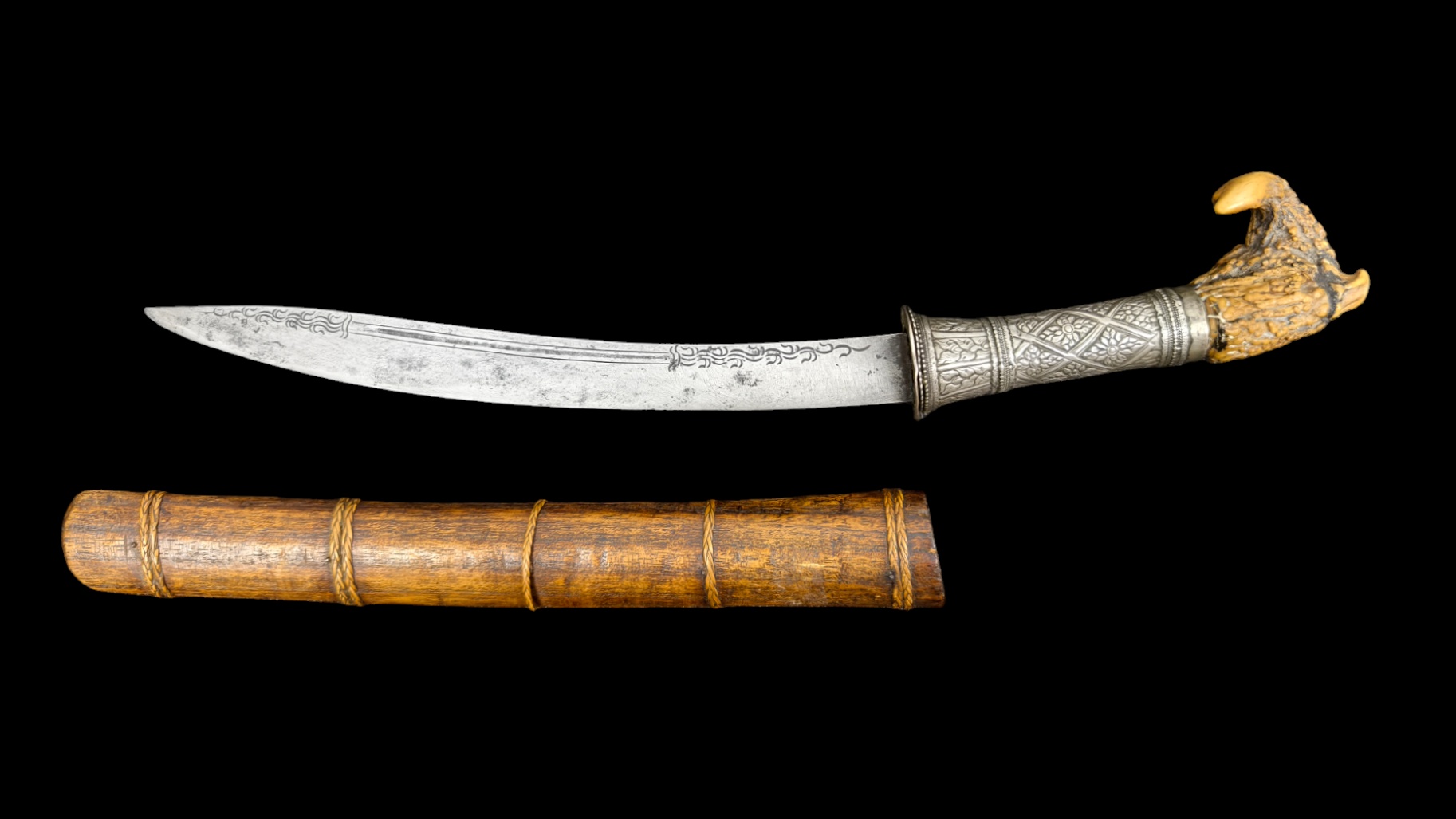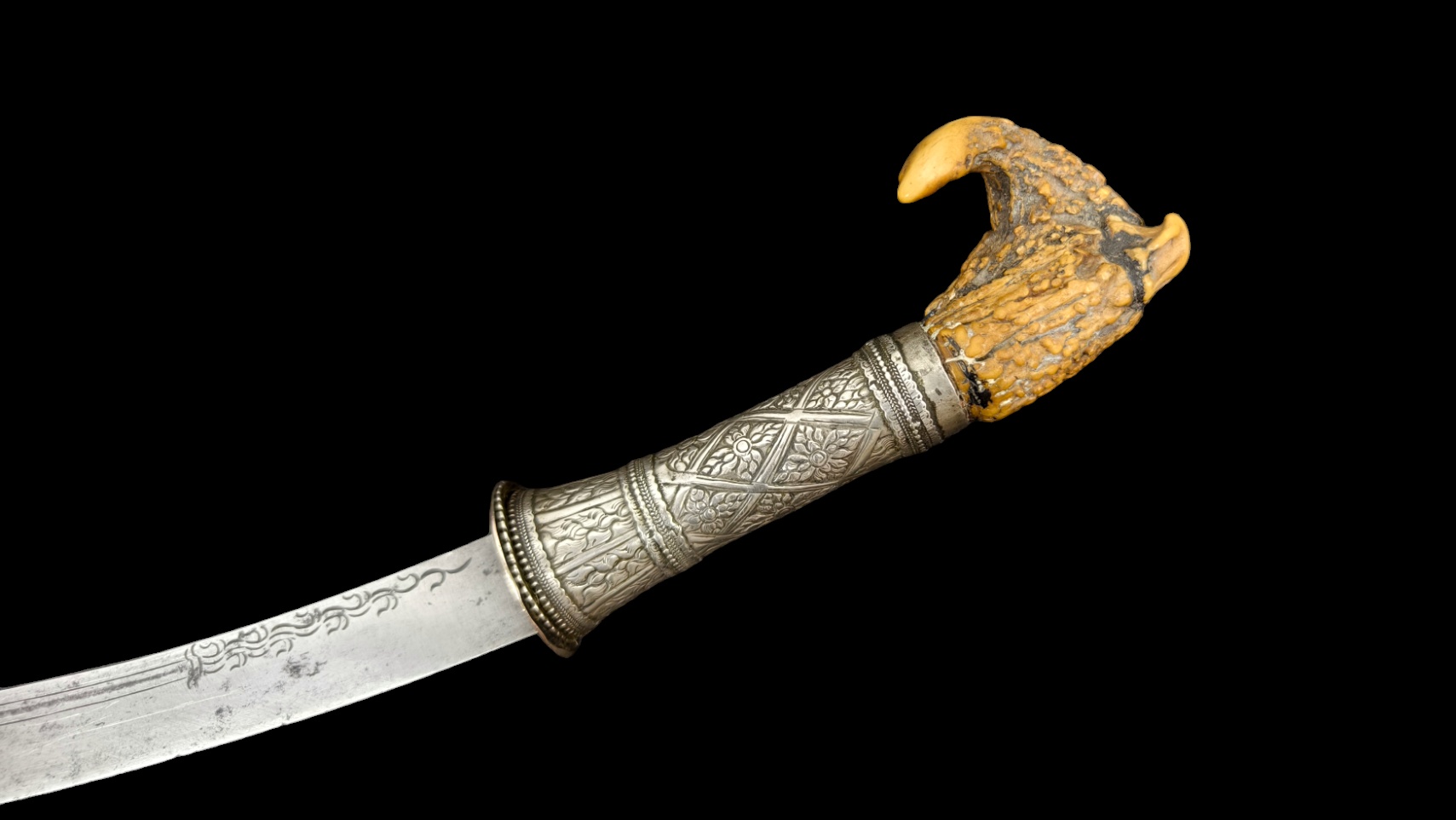
Knives, Ritual and the Muntjac
February 19, 2024 Asian Arms
Knives and their role in ritual are a theme seen across many cultures. Knives with magic connotations are also not unusual, as common implements they often feature in myth, legend and tales of magic, being a fundamental tool found in almost all cultures. In a Southeast Asian context these knives are often considered today to be amulets, that is items that convey certain powers on those that own or wear them and in western writing this is often conflated with "shamanic" use. The truth, as is often the case is slightly different but no less interesting.
This particular knife features a well made and sturdy blade, with a fairly pronounced curve and decoration typical of Lao and northern Thai manufacture, consisting of a shallow fuller and floral like motifs. It is a very slight v-spine and good thickness of 5mm at the base.

The tip is acute with the same decoration and the blade is sharp for the entire length.

The handle is comprised of beautiful and intricate silver work, with a round guard plate, a swelled tube and a joined grip tube, all with repousse floral designs.

However, by far the most unique aspect of this knife is the pommel, which made from the antler of a Muntjac deer.

The Muntjac is an interesting species, often referred to in English as a barking deer and found across Southeast Asia from Vietnam into Laos, Thailand, Cambodia and Burma. It is both a common species to hunt and also features in several prominent myths and legends.
In the Sakhon Nakhon Chronicle (a region in modern day Northeast Thailand), there is a legend regarding a certain king, who, due to a dispute, hunted an ancient Naga lord, who took the form of an albino or white Muntjac deer. After a pursuit the deer was mortally wounded and rather than continue to contest with mere mortals the Naga withdrew its spirit from the animal. However, the animal proved to have wonderous properties and no matter how much meat was cut from its carcass it continued to provide more venison. In the legend the Naga has its revenge on the king in the end, however for our purposes the interesting aspect is the association of the deer with the spirit world and the connection with hunting and sustenance.
.jpg)
(From a Dutch edition of 'Histoire naturelle ... ', by Georges-Louis Leclerc)
Unfortunately Lao specific primary sources are difficult to come by, but fortunately first hand knowledge in a Vietnamese context from the central highlands adds an interesting and useful perspective. The proprietor of an Ethnographic Gallery in Vietnam (http://54traditions.vn/) was kind enough to share direct information on similar knives which was subsequently made public on the Ethnographic Arms and Armour Forum some years ago. While this information covers blades of a different form, there is certainly an overlap in the tribal beliefs of ethnic groups both in modern day Cambodia, Laos and Isaan with deep rooted systems of spiritually focused on the natural world. According to this research, these knives are in fact made for hunters.
The antler is considered to have talisman properties. The male deer, which is the only one that has antlers, is a symbol of virility, and the fact that a hunter would possess an antler confirms luck for the hunt. This is in someways a universal concept of hunting, taking items from the hunted animals and treating them as symbols that both confirm the ability of the hunter and also ensure his future successes. Not only deer antler could be used, teeth, such as bear or tiger, are another powerful and adaptable symbol with their own connotations and place in the natural world and man's relationship with it.

The knife in this is not simply a talisman for luck, but is still a tool, used as part of the hunt, but imbued with the power and spiritual connection between man, the hunt and the spirit world which so often defines the result of these efforts.
Some of these blades are short, fat and designed for skinning. This particular example seems to be also suited for such common hunting tasks, with a tip and curvature ideal for breaking down a carcass.

As Southeast Asian societies became increasingly less reliant on hunting as a source of protein, these ancient relationships between hunters and nature, their understanding of the spirit world and the inherent "luck" involved within any expedition, show how it is easy to see how these abilities and beliefs became associated with magic and mysticism. Knowledge that became isolated, rare and less understandable to a general populace.
Today a knife like this may be considered to protect oneself from evil spirits or malign influences and are highly desired. The antler can also convey other attributes, in a Thai context it is also considered to provide protection from danger, prosperity, good fortune and more. Items like these illustrate the innate and organic relationship, the respect and concept of exchange between the hunter and the hunted, the known and unknown, and the bargain that is human survival in a harsh and unforgiving environment.